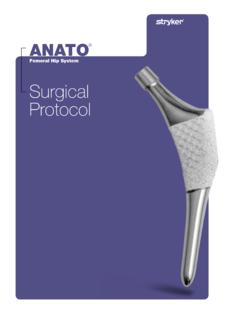Transcription of Reliance Femoral Component Surgical Technique - …
1 549_09_LRCMST_Rev1_Reliance_Component_ST _Layout 1 4/12/10 11:22 AM Page 1. Reliance Femoral Component Surgical Technique Using the Command Express Instrument System 549_09_LRCMST_Rev1_Reliance_Component_ST _Layout 1 4/12/10 11:22 AM Page 2. 549_09_LRCMST_Rev1_Reliance_Component_ST _Layout 1 4/12/10 11:22 AM Page 3. Reliance Femoral Component Surgical Protocol Using the Command Express Instrument System Technique Options Pre-operative Templating Surgical Approach The Command Express Instrument The Reliance Hip System offers a Each surgeon should use the Surgical System is extremely versatile, offering complete set of Femoral templates. All approach for total hip arthroplasty with surgeons great flexibility in approaching templates are at 120% magnification.
2 Which he/she is most familiar. Patient the implantation of the Reliance positioning, prepping and draping, the Femoral Component . This publication Acetabular Options skin incision, soft tissue dissection, and presents a basic Technique , followed by Stryker offers a wide variety of hip dislocation are performed according Technique Options at-a-Glance, an acetabular components that are to the surgeon's preferred Technique , overview of the system. compatible with the Reliance Femoral making certain to adequately expose the Component . The surgeon should refer acetabulum and the proximal femur. to a specific acetabular Component 's Surgical Technique for a discussion of acetabular Surgical procedures. Indications Contraindications Warning and Precautions Noninflammatory degenerative joint Active infection or suspected latent See package insert warning, precautions, disease, including osteoarthritis and infection in or about the hip joint; adverse effects and other essential avascular necrosis; Bone stock that is inadequate for product information.
3 Rheumatoid arthritis; support or fixation of the prosthesis;. Correction of functional deformity; Skeletal immaturity;. Revision procedures where other Any mental or neuromuscular disorder treatments or devices have failed; and, that would create an unacceptable risk Treatment of nonunions, Femoral neck of prosthesis instability, prosthesis fractures, and trochanteric fractures fixation failure, or complications in of the proximal femur with head post-operative care. involvement that are unmanageable using other techniques. Acknowledgements The Partnership System, which includes the Reliance Femoral Components and the Command Instruments, is a collaboration between Stryker and a group of orthopaedic surgeons and biomedical design engineers.
4 This team has developed an integrated series of implants and instruments designed to address the needs of patients, surgeons, and staff in today's changing healthcare environment. The design group includes: Lester S. Borden, MD Kenneth A. Krackow, MD Philip C. Noble, PhD. Retired Head Professor of Orthopaedic Surgery Dunn Professor of Orthopedic Research Adult Reconstructive Orthopaedic Surgery State University of New York at Buffalo The Methodist Hospital, Houston, TX. Cleveland Clinic, Cleveland, OH Department Head Department of Orthopaedic Surgery Hugh S. Tullos, MD . Edward T. Habermann, MD Buffalo General Hospital, Buffalo, NY. Roderick H. Turner, MD*. Anthony K. Hedley, MD, FRCS Roger N. Levy, MD*. President Arizona Institute of Bone & Joint Disorders Joseph C.
5 McCarthy, MD. Phoenix, AZ Director, Center for Joint Reconstruction Surgery David S. Hungerford, MD Newton Wellesley Hospital, Boston, MA. Professor of Orthopaedic Surgery Vice Chair for Program Development, Johns Hopkins University, Baltimore, MD Orthopaedic Surgery Good Samaritan Hospital, Baltimore, MD Massachusetts General Hospital, Boston, MA. Deceased * Retired This publication sets forth recommended procedures for using Stryker devices and instruments. It offers guidance that you should heed, but, as with any such technical guide, each surgeon must consider the particular needs of each patient and make appropriate adjustments when and as required. 3. 549_09_LRCMST_Rev1_Reliance_Component_ST _Layout 1 4/12/10 11:22 AM Page 4.
6 Reliance Femoral Component Surgical Protocol Starting [B]. 1 Determine and Mark the Osteotomy Level 1. By using anatomic landmarks identified during templating, the osteotomy guide identifies the location of the osteotomy cut. The osteotomy guide has several features to assist the surgeon (Figure 1): [A] Long tail of the osteotomy guide for alignment with the Femoral shaft axis. [C]. [B] Notch in the proximal portion of the guide references the proximal tip of the greater trochanter. [C] Neck resection level. Care must be taken to restore proper leg length by referencing the osteotomy level back to the center of rotation of the implanted acetabular Component . [A]. The resection level should be about a fingerbreadth above the lesser trochanter.
7 An angled surface provides a plane for marking the level of the cut, or can be used as a cutting surface for the sawblade. 2 Perform Osteotomy 2. A 40 osteotomy angle allows a single cut across the neck, and generally eliminates the need for a second cut to complete the resection (Figure 2).. Additional options available; see Appendix 2, page 15. 4. 549_09_LRCMST_Rev1_Reliance_Component_ST _Layout 1 4/12/10 11:22 AM Page 5. 3. 3 Open and Size the Canal with Starter Awl The tapered starter awl is a hand-operated instrument designed to open the Femoral canal and indicate distal diameter size. Assemble small hex T-handle onto starter/sizer awl, and target piriformis fossa to open canal. Progress the awl distally until some cortical resistance is achieved.
8 Use aggressive cutting teeth of starter awl to achieve lateralization (Figure 3). For additional reaming options see Appendix 2;. page 16. 4 Depth of Starter Awl 4. Make note of millimeter diameter marking [A] that appears at the medial osteotomy level (Figure 4). These marking grooves on shaft identify distal diameter sizing of Femoral canal. Reliance CM Minimum Stem Size Distal Canal Diameter Required 1 11mm [A]. 2 12mm 3 13mm 4 14mm 5 15mm Reliance PF Minimum Stem Size Distal Canal Diameter Required 0 10mm 1 11mm 2 12mm 3 13mm 4 14mm 5 15mm 6 16mm 7 17mm 5. 549_09_LRCMST_Rev1_Reliance_Component_ST _Layout 1 4/12/10 11:22 AM Page 6. Reliance Femoral Component Surgical Protocol Broaching 5 Select Fully Toothed Broach 5.
9 There are two styles of broaches available: Fully Toothed and Universal. The Fully Toothed broach is featured here (Figure 5). Select a broach one size smaller than the anticipated implant size, based on pre-operative templating. Attach handle to broach by inserting trunnion of the broach into broach handle and turning the locking knob in the direction indicated (Figure 5). Reliance CM*/PF Fully Toothed Stem Size Broach Size 0 0. 1 1. 2 2. 3 3. 4 4. 5 5. 6 6. 7 7. * Reliance CM available in stem sizes 1-5 only. If the Universal Broach is selected then reaming is essential. 6 Introduce Broach 6. Introduce broach into proximal femur. Drive the broach down the canal with a mallet, keeping it aligned with the neutral Femoral axis.
10 Assess fit and resistance to movement. If a larger size is needed, remove the broach and replace it with the next largest size. To facilitate final seating of the broach, partially withdraw the broach to clear cutting teeth of bone; then re-introduce the instrument into the canal (Figure 6). 6. 549_09_LRCMST_Rev1_Reliance_Component_ST _Layout 1 4/12/10 11:22 AM Page 7. 7 Calcar Planer 7. Leave the final broach seated in the canal. Remove the broach handle. The broach trunnion may be used as a guide for the calcar planer. The calcar planers come in two sizes: standard and large. Select the proper size planer and assemble it to the power adaptor. The female bushing on the planer is guided over the broach trunnion (Figure 7).














